Open Access Library Journal
2020, Volume 7, e6090
ISSN Online: 2333-9721
ISSN Print: 2333-9705
Utilization of Social Media Platforms among
Information Science Students at University of
Kabianga
Geoffrey Maweu1, Omondi Aguok Yudah2
1School of Information Science and Knowledge Management, Department of Publishing, Media & IT, University of Kabianga,
Kericho, Kenya
2School of Information Science and Knowledge Management, Department of Information Science & Technology University of
Kabianga, Kericho, Kenya
How to cite this paper: Maweu, G. and
Yudah, O.A. (2020) Utilization of Social
Media Platforms among Information Science
Students at University of Kabianga. Open
Access Library Journal, 7: e6090.
https://doi.org/10.4236/oalib.1106090
Received: January 19, 2020
Accepted: March 13, 2020
Published: March 16, 2020
Copyright © 2020 by author(s) and Open
Access Library Inc.
This work is licensed under the Creative
Commons Attribution International
License (CC BY 4.0).
http://creativecommons.org/licenses/by/4.0/
Open Access
Abstract
Social media has rapidly revolutionized the information and communication
domain in the world. The applicability of social media in the academic sphere
is occasioned by prospects and challenges. Consequently, it has created a
bone of contention within the academic realm. The study therefore reviewed
social media applications and their preferential utilization by university stu-
dents in knowledge sharing. This study seeks to address the research problem;
the university management has endeavored in connecting the institutions
with the outside world through developing information communication and
technological (ICT) infrastructures. However, little is known on how students
use new media technologies for academic purposes. The study adopted a de-
scriptive research design, where closed-ended questionnaires were distributed
to the respondents. The respondents comprised of 103 students in the Uni-
versity of Kabianga, school of information science and knowledge manage-
ment. The research revealed that students use social media majorly for enter-
tainment purposes. Subsequently, it realized that the new media affect uni-
versity students both positively and negatively but without authentic studies
locally. It is hoped that this study will shade more light than darkness into
the application of new media formats in learning at Kenyan universities.
This will open new avenues of knowledge sharing and networking for maxi-
mum utilization of mined and captured information within the academic
corridors.
Subject Areas
Information Science
DOI: 10.4236/oalib.1106090 Mar. 16, 2020
1
Open Access Library Journal
�
G. Maweu, O. A. Yudah
Keywords
Social Media, New Media, University Students, Knowledge Sharing
1. Introduction
Social media platforms are preferred by university students as a means for
knowledge sharing. This is due to their features and capabilities that encourage,
support and enable people to share knowledge easily and effectively through dif-
ferent mechanisms. Universities generate Knowledge diversely at different levels,
ranging from individual projects, group discussions, brain storming sessions and
research undertakings. Once the generated knowledge has been captured for
whatever purposes, it remains to be shared and disseminated within and without
university realm. Scholars and practitioners widely recognize knowledge as critical
asset for individuals as well as organizations’ success in the increasingly compet-
itive environment [1]. It is common knowledge that people are the best means of
getting meta-knowledge about our search target and capabilities. For instance,
talking to each other provides a highly valuable learning activity that is primarily
a tacit-tacit knowledge transfer, which is knowledge that resides in people or ex-
pert minds (Artificial Intelligence). New invention of technology offers a new
medium through which individuals that share similar interests, problems and
responsibilities can share knowledge. Social media is the possibility of people to
create their own content and to easily be able to share the content [2]. This content
is not imposed by others or by rules, people are free to pursue their own needs. This
ensures that the information or knowledge that is shared really comes from the self,
and that it can be expressed the way it was actually meant.
1.1. Statement of the Problem
Social media platforms are increasingly playing a key role in the techno savvy
population’s lives. This is by allowing people to interact and communicate across
the world including in Kenya. In recent times, institution of high learning has
adopted social media as a mode of delivery, a tool for learning and a communi-
cation channel between lecturers, students, management staff, researchers and
other key stakeholders. This has seen the developments of Knowledge mining,
organization and sharing grow into systems as well as reliance on group re-
sources alongside other mechanisms for the improvement of students, lecture
deliveries and management of varsities. The usage of social media in learning
offers students with the capability to get more value added information, to
connect with others, which makes academic knowledge sharing in education
convenient. Social media tools in the academia community give students, lectur-
ers, managers among others with a wide range of possibilities in the improve-
ment of learning methods. Through the networks, it becomes possible to share
and interact remotely. Students also make use of online tutorials as additional
2
Open Access Library Journal
DOI: 10.4236/oalib.1106090
�
G. Maweu, O. A. Yudah
knowledge resources that are shared through the social platforms.
However, despite the enormous efforts by the university management in de-
veloping information communication and technological (ICT) infrastructures,
little is known on how students use new media technologies for academic pur-
poses. In view of the fore going, the study examines the application and use of
new media platforms on knowledge sharing together with the arising challenges
in the University of Kabianga, School of Information Science and Knowledge
Management.
Purpose of the Study
This study aims at assessing the application of new media platforms on know-
ledge sharing in university of Kabianga, specifically by exploring the use of social
media in lecture halls by both the lecturers and students, with an intention of
developing the best practice of academic knowledge sharing and encouraging
linkages and knowledge networking.
1.2. Significance of the Study
The study will shade light on the best practices for the use of social media in
university education as a form of knowledge sharing avenue. This understanding
will guide the proper usage hence influencing the learning environment to the
advantage of the students, lecturers, researchers and other stakeholders in the
varsity communities.
2. Literature Review
The use of new media applications has been rising rapidly during last few years
and as Patil asserts, it is not only being used by the working people but also there
is heavy increase in the use of social media by the students or education society
[3]. A 2015 survey conducted in Zambia, established that 71% of Zambians use
internet on almost a daily basis with 63% of them being university students [4].
And while there are no corresponding statistics regarding the use of Internet by
Kenyan university students, it is safe to conclude that its use is widespread with-
in the corridors of Kenyan institutions of higher education both by the students
and their lecturers. It’s positive or negative effects notwithstanding; various stu-
dies have conclusively established that the use of social media by university stu-
dents and in the education sector in knowledge sharing is widespread and ac-
ceptable if not almost mandatory.
2.1. Application of New Media in Knowledge Sharing, Teaching
and Learning
The use of new media in knowledge generated resource sharing within universi-
ties cannot be over-emphasized. The question thus is the extent of its adoption
by the university community and how they use it. Is it for academic purposes or
leisure? Similarly, how do lecturers use social media in engaging with their stu-
dents? Is the line between educational use and other leisurely activities thin or
3
Open Access Library Journal
DOI: 10.4236/oalib.1106090
�
G. Maweu, O. A. Yudah
blurred among the teaching staff of varsities and their students? Also, what are
the negative and positive impacts of social media use in resource sharing within
the education sector? [5] suggested that social media might be very useful when
it comes to academic issues, i.e. discussion boards among classmates and Face-
book page for school programs. However, an opposite finding revealed by [6],
showed that social media has negative effects on the students’ academic perfor-
mance. The students’ proficiencies and grades were affected through use of so-
cial media. With studies giving conflicting conclusions, where will sanity be
found or is it a lost case?
2.2. Social Media Usage in Knowledge Management by University
Students
As indicated in the above section, various studies have unanimously agreed that
university students are notorious when it comes to usage of social media, be it
for educational purposes or otherwise. Additionally, studies have made conflict-
ing conclusions in regard to the impact of social media usage by varsity students
with some indicating it has positive impacts while others disagree. There are no
studies or concrete statistics on the same in the Kenyan universities, but the
truth cannot be far from the conclusions of these studies. Thus the existence of
numerous Facebook pages and groups, WhatsApp groups and telegram channels
owned by university students and discussing university issues, educational and
otherwise attest to the fact that usage of new media is not alien to academic
community. Sheer observation will tell you that almost everyone at the universi-
ty owns or at least use a smartphone (technologically referred to us palmtops),
gadgets which have the ability to carry new media platforms and programs.
3. Methodology
The research adopted a descriptive survey research design. Closed ended ques-
tionnaire was used to collect data from the respondents. The respondents com-
prised of 103 students in the University of Kabianga, school of information
science and knowledge management. This population was selected because it
was convenient. The data collected from the field was complemented by second-
ary data from books and journals, which are found online via google scholar,
and Emerald, among other websites.
4. Findings
4.1. Forms of Social Media Used by Students
Figure 1 below shows that the devices used in accessing social media forms. It
that 17 (34.0%) responded used smartphone/DPA, 1 (2.0%) indicated lap-
top/computer, and 32 (64.0%) students responded by smartphone the use of
both devices. The researcher deduced that the majority of the responded pre-
ferred using dual-devices and then followed by (34.0%) responses indicating the
use of smartphone devices in accessing social media forms. Similarly, most
4
Open Access Library Journal
DOI: 10.4236/oalib.1106090
�
G. Maweu, O. A. Yudah
Figure 1. Devices used in accessing social media.
students could afford Laptops and computer systems and, therefore, would al-
ternatively resort to the smartphone as the preferred device in accessing social
media.
Having acknowledged the common usage of smart phones by the respon-
dents, the researcher sought to establish the form of social media adopted. Fig-
ure 2 below shows the distribution of various forms of social media in smart-
phones. Figure 2 shows forms of social media in social media, where Facebook
had 39 (22.8%), Twitter 27 (15.8%), Instagram 25 (14.6%), WhatsApp 45
(26.3%), You Tube 30 (17.5%) and Snapchat 5 (2.9%) respondents. The high
frequency of each form of social media was as a result of having choice of selec-
tion of more than one form.
4.2. Usage of Social Media in Academia
The research sought to understand the forms and means of social media usage in
academia. It was established that a significant majority of the respondents, 46
(94%) indicated that they use social media in sharing academic content. Conse-
quently, the small insignificant portion of the respondents, 4 (6%), suggested
that they don’t use social media in scholarly knowledge sharing. The over-
whelming use of social media is occasioned by the well-established technological
wire-less internet connection within the campus, and above all, most students
are tech-savvy.
An in-depth analysis of the forms of the platforms used by the respondents
revealed that majority, 45 (69.2%) used WhatsApp as a conventional means of
knowledge sharing, followed by Facebook 8 (12.3%). Other forms included You
Tube 6 (9.2%), twitter 4 (6.2%), and Instagram and LinkedIn trailing with a
minute 1 (1.5%). Students highly prefer WhatsApp because of its flexibility and
ability to create group communication, thus facilitating mass interaction.
Therefore, most respondents who have smartphones are members of WhatsApp
a group. On the contrary, LinkedIn and Instagram surprisingly attracted the
5
Open Access Library Journal
DOI: 10.4236/oalib.1106090
�
G. Maweu, O. A. Yudah
Figure 2. Forms of social media in smart phones.
smallest possible number of respondents. The small numbers are attributed to
fact that LinkedIn is majorly used for professional linkages while twitter is
usually followed opinion leaders, and most respondents are not interested in
following opinion leaders or professionals’ (Figure 3).
Figure 3. Social media platforms.
4.3. Factors Affecting Academic Knowledge Sharing
The researcher sought to determine the factors influencing the use of social me-
dia in sharing academic knowledge. It was revealed from the table that the res-
pondents are driven by self-motivation 27 (54.0%), followed by organizational
culture 13 (26.0%) and finally enjoying helping others 10 (20.0%). Majority of
the respondents indicated that self-motivation pays a significant role in know-
ledge sharing. This high number of respondents is attributed to the personal
conviction and the collective urge of sharing knowledge through group discus-
sions and assignments (Figure 4).
4.4. Factors Hinders Sharing Academic Knowledge through Social
Media
Figure 5 illustrated on the factors that hinder students from sharing academic
6
Open Access Library Journal
DOI: 10.4236/oalib.1106090
�
Figure 4. Factors affecting knowledge sharing.
G. Maweu, O. A. Yudah
Figure 5. Factors hindering academic knowledge sharing.
knowledge through social media. Majority of the respondents 16 (32.0%) saw
lack of technological support as the major hindrances, while 12 (24.0%) blamed
it on lack of time, 12 (24.0%) saw others factors, 6 (12.0%) were trust issues, 3
(6.0%) saw degree of competition among course mates and finally 1 (2.0%) was
having fear/technophobia. This clearly reveals that those who do not share aca-
demic knowledge claimed lack of technological support as the major hindrances.
5. Discussions of the Findings
5.1. Types of Social Media
Major development of Web applications during the last decade, termed as Web
2.0, is the emergence and intensive use of social networking sites (SNS). Exam-
ples of SNS are Myspace, Facebook, LinkedIn, Twitter, Flicker, Instagram, and
WhatsApp. Tango, Line, Yahoo, Hike, We Chat, Skype, Imo, BBM, Viber etc.
[7]. Social media users create, share and/or exchange information and ideas in
virtual communities and they are able to network with other members who
share similar or common interest, dreams and goals [8].
7
Open Access Library Journal
DOI: 10.4236/oalib.1106090
�
G. Maweu, O. A. Yudah
5.2. Popularity of Social Media Sites among the Varsity Students
Just like the evolution of the higher education system in Kenya and globally, the
new media has also greatly changed at an even higher pace. New social media
platforms have killed the old ones. WhatsApp for instance rendered BBM obso-
lete, while the secure and secretive nature of Telegram has left snapchat and 2go
redundant. There are social media platforms that are more popular than others
among the university students and within the general populace.
Studies on the preferred social media platform have established that What-
sApp remains the most popular social media application. A Ghanaian study
found that the majority of students used WhatsApp as the most widely used so-
cial media platform followed by Facebook and Twitter [9]. While students use
social media in other leisurely and formal activities, within the context of educa-
tion, students mainly use the new media for communication with lecturers
according to.
5.3. Knowledge Sharing in Teaching and Learning through Social
Media
According to [10] social network sites have attracted considerable attention
among scholars and educators due to the increasing popularity among students
and the potential effect on academic performance.
Hypothetically, there are many ways in which social media can be used in
teaching and learning at the university. This includes communication, informa-
tion sharing (remotely—that is away from class—and in class), video conferenc-
ing, projecting on the wall, research and actual learning itself. However, [8] avers
that the new media is predominantly used only to communication between the
classmates, fellow students and also with lecturers.
Social media are mostly used by students to communicate and exchange ideas
with lecturers specifically in western contexts.
At the University of Kabianga, it is widely acceptable and public knowledge
that students share information regarding learning and other corresponding
tasks amongst themselves, while lecturers send reading materials and assign-
ments to students through social media platforms such as gmail’s hangout among
others. This in essence promotes knowledge organization, retrieval and sharing
within the university academic community. Students also submit assignments
and communications to the lecturers through the same.
Students in similar common units have been known to form WhatsApp groups
where they invite their lecturers and use the platform to share and discuss purely
academic knowledge related issues by information request and sharing regarding
the said unit.
5.4. Adoption of Social Media Platforms by Students
A 2015 study in Zambia, as mentioned in the introduction, indicated that 63% of
social media users in the country are in the university sector. A recent study by
8
Open Access Library Journal
DOI: 10.4236/oalib.1106090
�

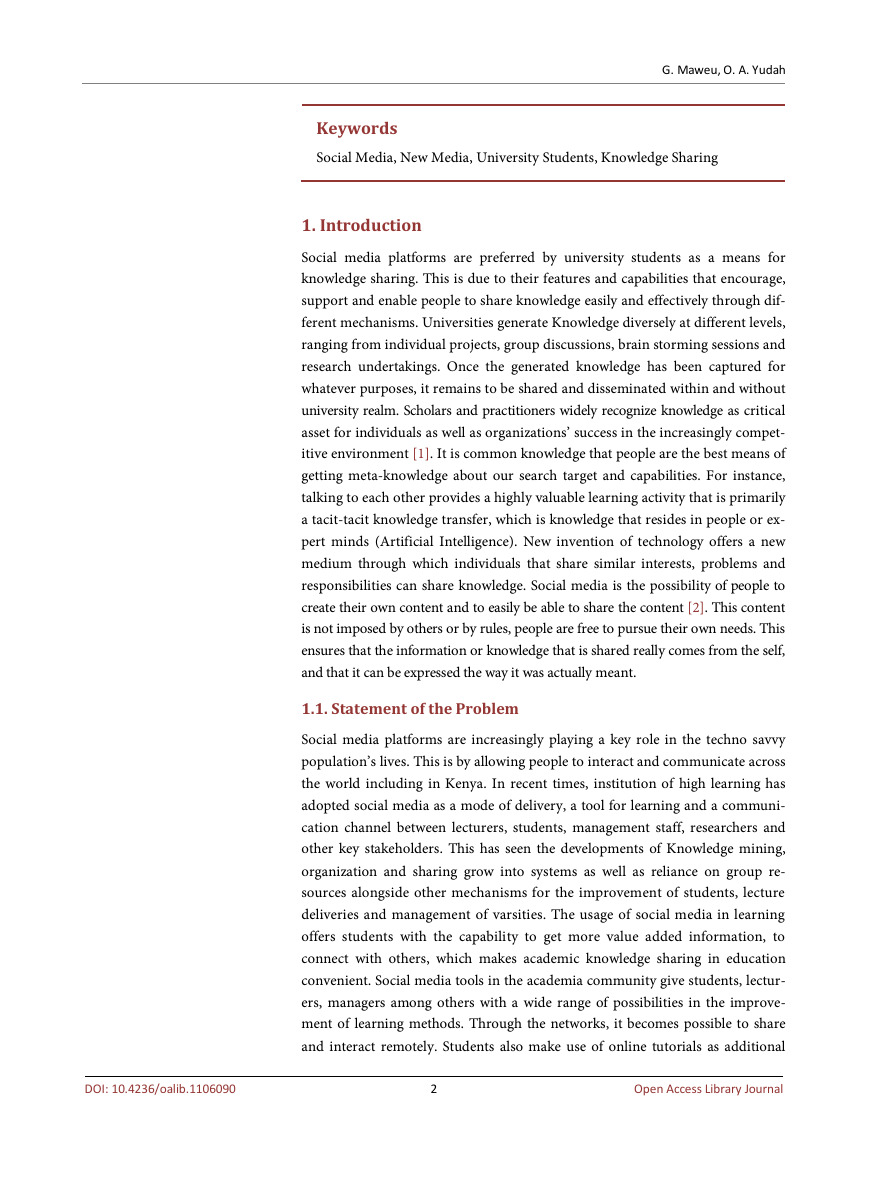
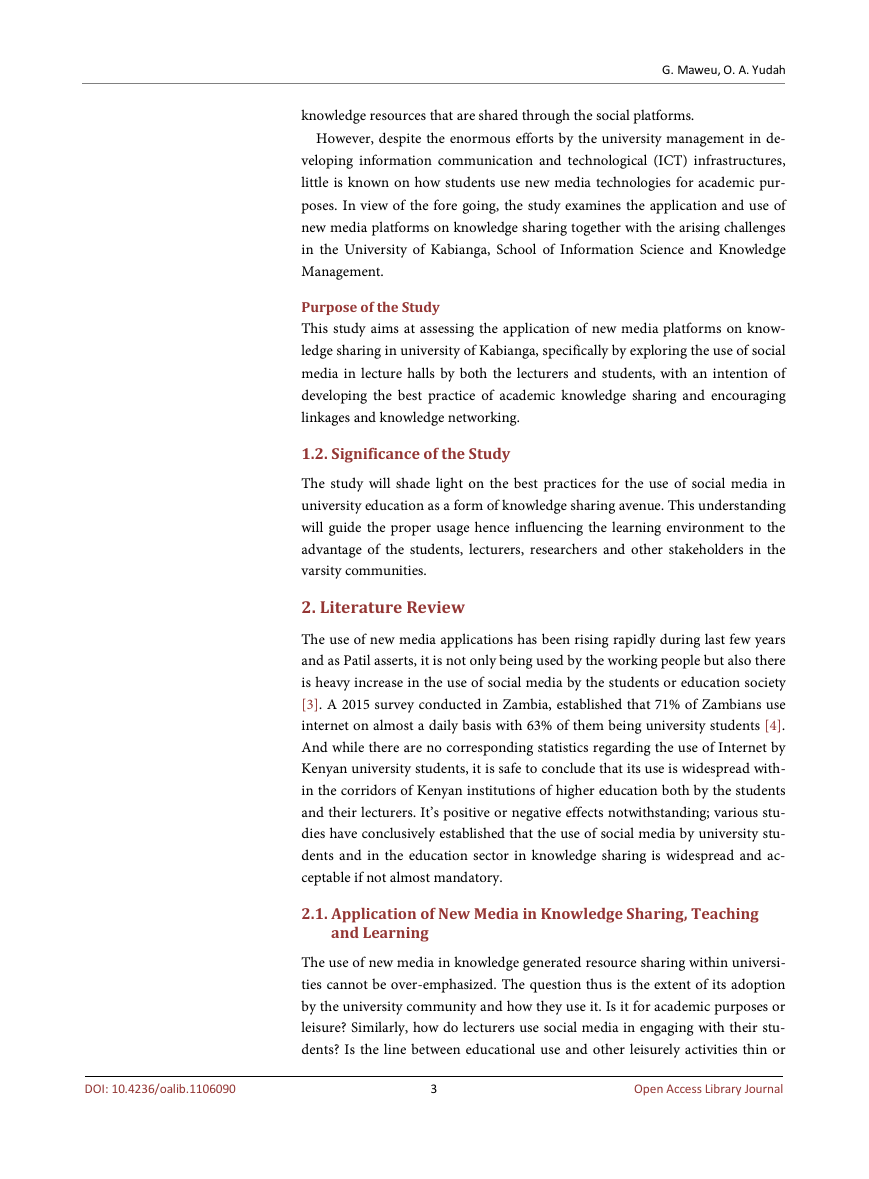
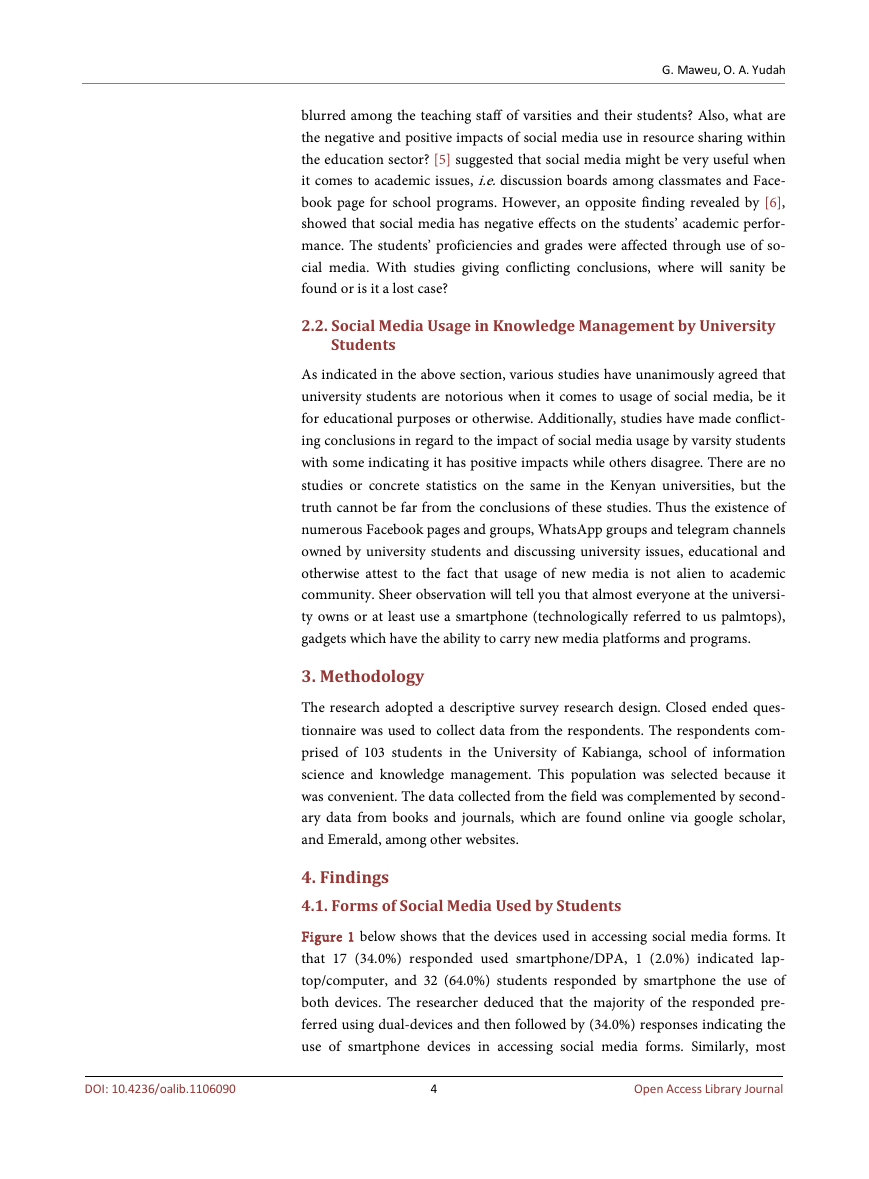
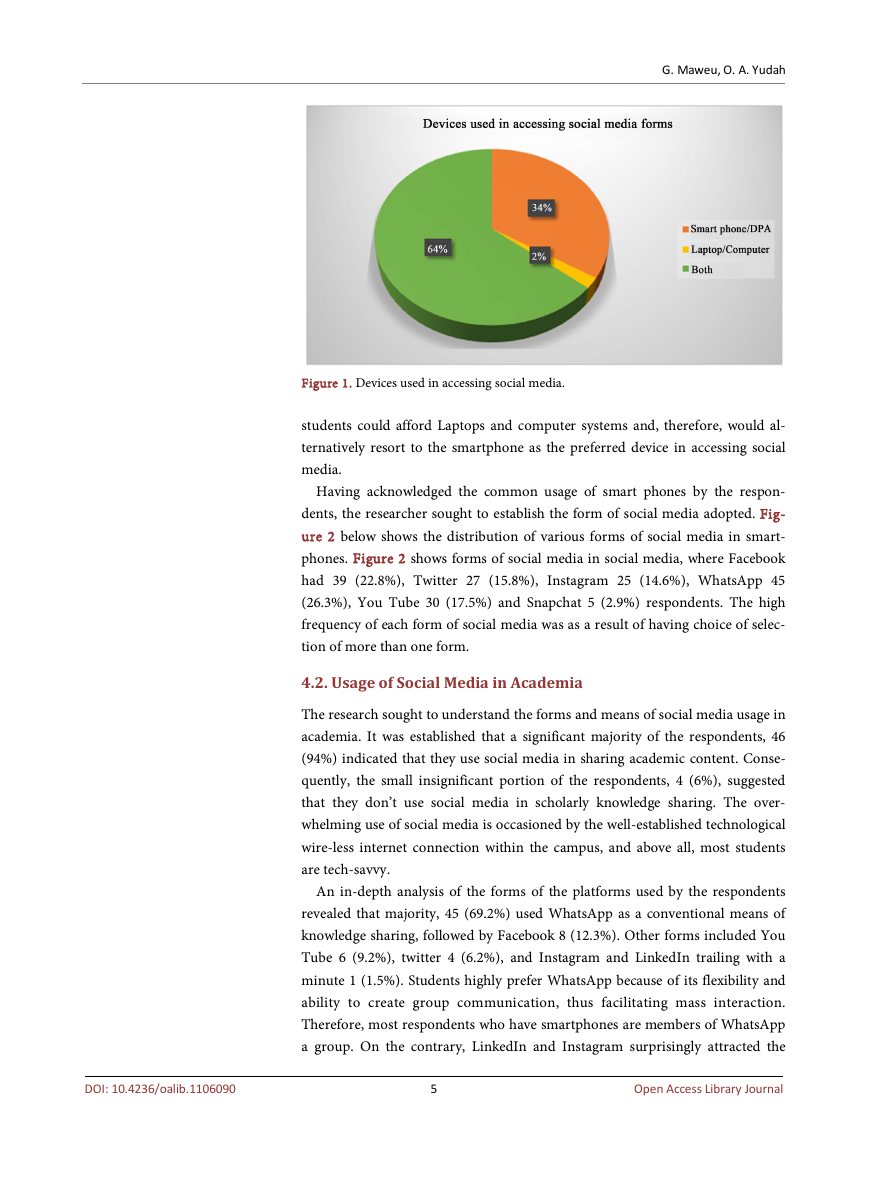
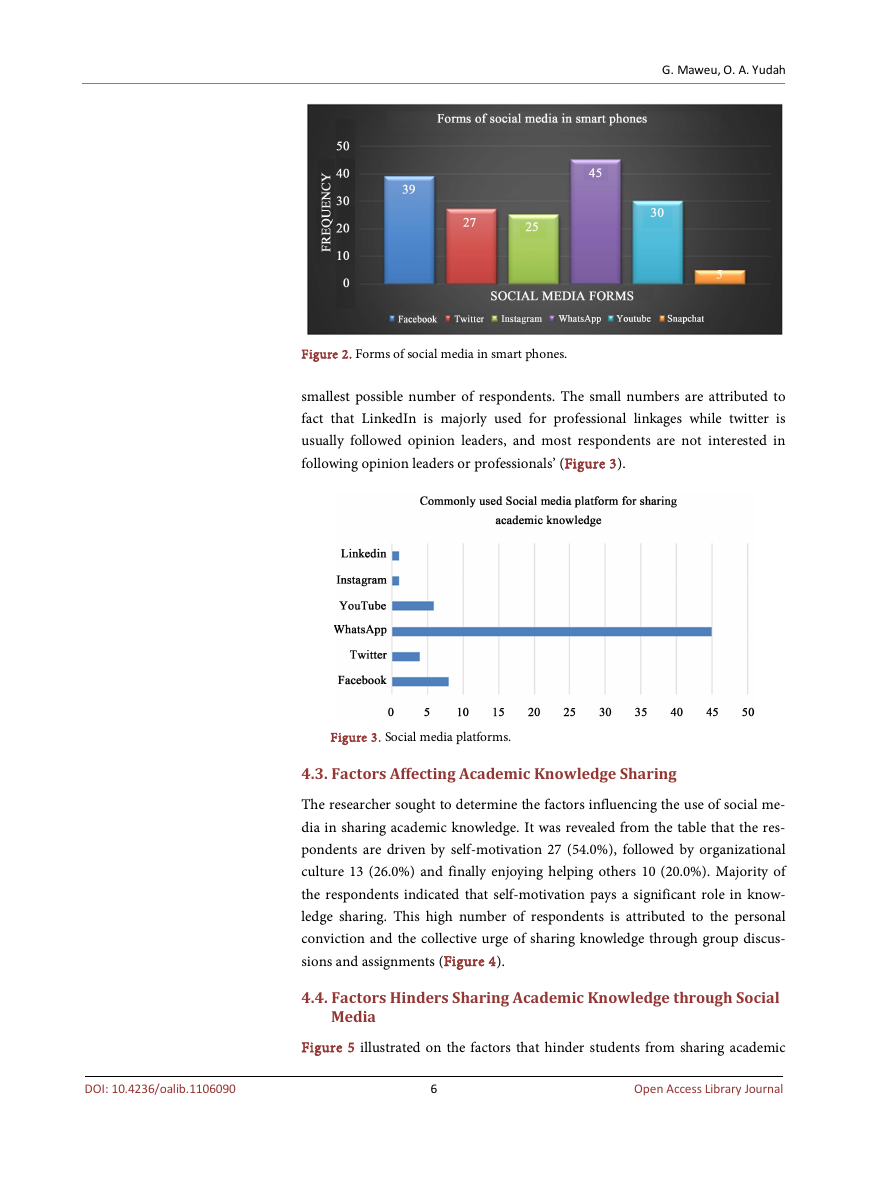
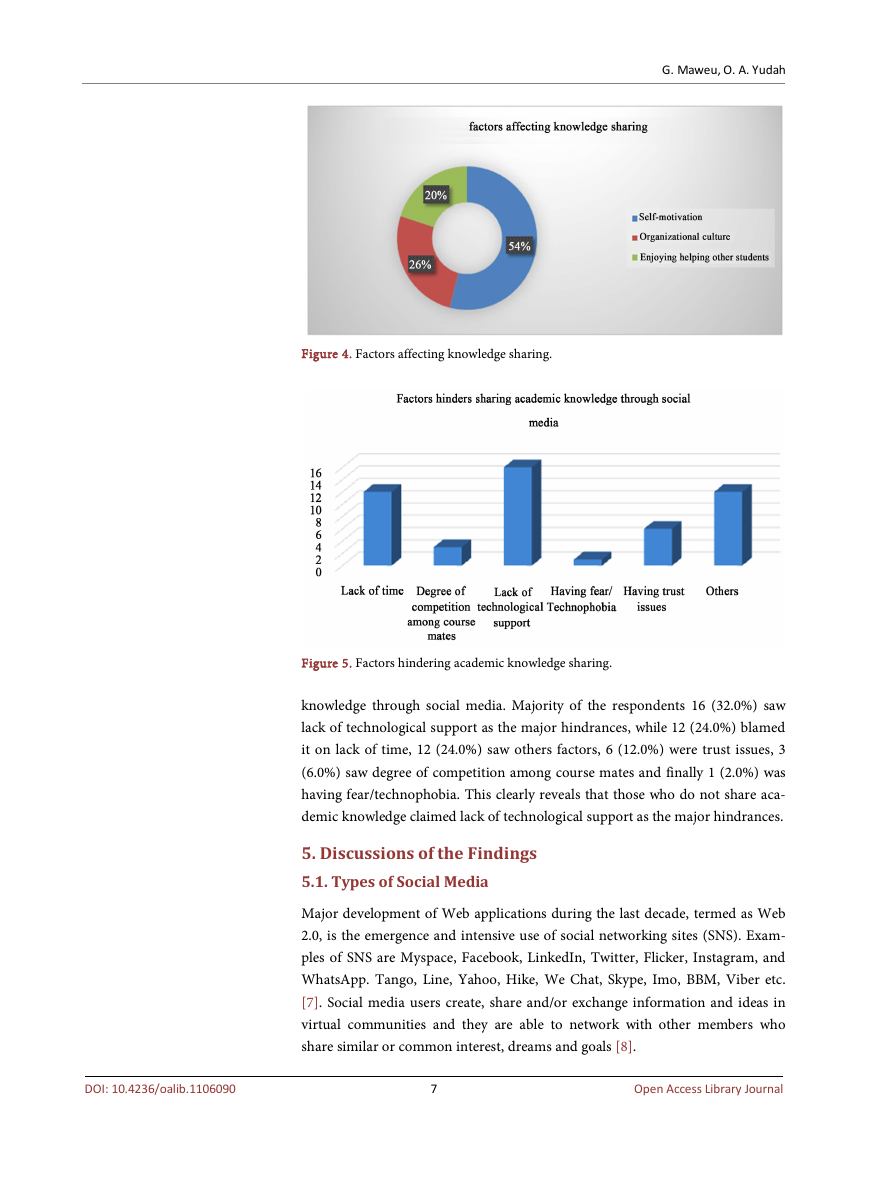









 2023年江西萍乡中考道德与法治真题及答案.doc
2023年江西萍乡中考道德与法治真题及答案.doc 2012年重庆南川中考生物真题及答案.doc
2012年重庆南川中考生物真题及答案.doc 2013年江西师范大学地理学综合及文艺理论基础考研真题.doc
2013年江西师范大学地理学综合及文艺理论基础考研真题.doc 2020年四川甘孜小升初语文真题及答案I卷.doc
2020年四川甘孜小升初语文真题及答案I卷.doc 2020年注册岩土工程师专业基础考试真题及答案.doc
2020年注册岩土工程师专业基础考试真题及答案.doc 2023-2024学年福建省厦门市九年级上学期数学月考试题及答案.doc
2023-2024学年福建省厦门市九年级上学期数学月考试题及答案.doc 2021-2022学年辽宁省沈阳市大东区九年级上学期语文期末试题及答案.doc
2021-2022学年辽宁省沈阳市大东区九年级上学期语文期末试题及答案.doc 2022-2023学年北京东城区初三第一学期物理期末试卷及答案.doc
2022-2023学年北京东城区初三第一学期物理期末试卷及答案.doc 2018上半年江西教师资格初中地理学科知识与教学能力真题及答案.doc
2018上半年江西教师资格初中地理学科知识与教学能力真题及答案.doc 2012年河北国家公务员申论考试真题及答案-省级.doc
2012年河北国家公务员申论考试真题及答案-省级.doc 2020-2021学年江苏省扬州市江都区邵樊片九年级上学期数学第一次质量检测试题及答案.doc
2020-2021学年江苏省扬州市江都区邵樊片九年级上学期数学第一次质量检测试题及答案.doc 2022下半年黑龙江教师资格证中学综合素质真题及答案.doc
2022下半年黑龙江教师资格证中学综合素质真题及答案.doc